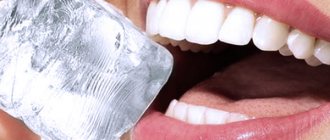If your teeth have a painful reaction to cold or hot food, sweet, sour, toothpaste, or simply to biting and chewing food, then you have hyperesthesia - increased sensitivity of the teeth. According to the World Health Organization, about 60% of the world's population suffers from increased sensitivity of hard dental structures. It manifests itself in the form of mild discomfort or unbearable short-term pain, sometimes becoming sharp and throbbing.
Causes of hyperesthesia
Dental hypersensitivity is caused by many factors and may indicate problems with the teeth and periodontal tissues. Hypersensitivity is one of the most common diseases in dental practice and, according to WHO, is increasing every year.
The mechanisms of the occurrence of pain syndrome due to irritating factors stimulate increased interest among both researchers and practicing dentists, prosthetists, and hygienists. This attention is explained by the fact that pain is a key symptom of most dental diseases. However, the increased susceptibility of hard tissues cannot be justified by the known pathways of nerve signal transmission. This fact prompted a series of studies to be carried out, which resulted in several theories of the development of hyperesthesia:
- odontoblastic;
- receptor;
- threshold;
- hydrodynamic.
Sufficient evidence has been collected in favor of the hydrodynamic theory. It is supported by most dental clinicians. The dentinal tubule, according to theory, is considered as a capillary tube containing fluid inside.
Exposure to air, high temperatures, etc. it shifts, the pressure in the dentin changes. This leads to increased activity of nerve endings. Penetration of irritants into the tubules is possible when dentin, the main hard tissue of the tooth, is exposed. It is exposed not only against the background of carious lesions and diseases of periodontal tissues, but also as a result of non-carious defects: hypoplasia (underdevelopment of teeth), enamel erosion, etc.
How sugar negatively affects our teeth
Sugar can cause destruction not only of the upper enamel coating, but also of dentin. Frequent consumption of sweets contributes to the formation of small cracks, which are gradually filled with glucose. It is an ideal breeding ground for bacteria, whose active activity is responsible for toothache after eating sweets. Increased acidity forms in the resulting microgaps, which subsequently stimulates the rapid development of caries.
Important. It is necessary to regulate the amount of sugar in the diet, because digesting this component requires a considerable amount of B vitamins and calcium - elements that form the basis of dental tissue. In other words, a lot of sweets means little strength for your teeth.
Hypersensitivity after tooth filling and preparation for dentures
Most often in dental practice, increased sensitivity is observed after filling. Patients come to the clinic with complaints of sensitivity, especially to cold, without precise localization of pain. Upon visual examination, sensitivity in the basal part is not detected. There is no evidence of open pulp or caries on the x-ray.
The causal unit, however, can be identified. To do this, use ice, which, wrapped in a paper napkin, is applied to the cheek area or to the surface of the tongue. An area with a violation of integrity in hard tissues is a source of irritation, so severe pain occurs in the tooth. Removing all filling material will allow you to detect the break.
The reason for increased susceptibility, often to cold or too hot food, may be the appearance of microgaps between the filling and the hard tissues of the tooth due to compression of the composite material. The gap formed in the cavity near the root canals opens up space for the movement of dentinal fluid, thereby causing a response from the nerve endings of the pulp.
The area of contact of the material with the walls of the internal space of the tooth can also contribute to the formation of hypersensitivity after filling. Since filling composites have a high elasticity index, they cause stress in the contact layer “filling - hard dental tissue”. The tension in the tooth tissues is greater in cases where the surface of the restoration in contact with the walls is extensive.
After preparation (grinding) of a tooth for prosthetic structures and microprostheses, normal sensitivity is observed, which is characterized by mild pain. If there is no inflammatory process in the pulp, the pain is considered causative and disappears a few minutes after the drill stops working. If hypersensitivity persists for a long time (2 or more days after the procedure), treatment of pulpitis is required.
conclusions
Tooth pain from sweets is the most common question in dental offices. This is a solvable problem, but if you don’t focus on it in time, unpleasant consequences are inevitable. In addition, this is a primary issue not only of health, but also of the social aspect in general. A person who experiences cutting pain over and over again (even for a short period of time) cannot feel comfortable in society. The reasons for this feeling can be various factors - from cold or hot food, to a crack in the tooth and damage to the enamel. The consequences include not only pain, but also complete tooth decay over time. Timely treatment in this case is one of the ways to prevent tooth loss. This issue is especially acute for people aged 20-40 years.
More fresh and relevant information about health on our Telegram channel. Subscribe: https://t.me/foodandhealthru
We will be grateful if you use the buttons:
Provoking factors for the development of dental hypersensitivity
Most often, increased sensitivity is a consequence of a violation of the integrity of the enamel or destruction of the hard tissues of the teeth, which increases the risk of irritation of the endings of the nerve fibers.
The key provocateurs are caries lesions, exposure of the necks and roots of the teeth. Hyperesthesia is diagnosed as a sign of a number of non-carious lesions - enamel defects, progressive loss of enamel and dentin with a decrease in crown height, local destruction, acid necrosis, traumatic injuries, periodontitis with an aggressive course, metabolic disorders of the body, endocrine diseases, mental disorders.
The disease can also occur when consuming large quantities of acidic foods and drinks. Under the influence of acids, the enamel softens and loosens, and erosion appears on its surface.
Increased sensitivity of teeth can be observed after removal of hard dental tissues in order to create a prosthetic space for metal-ceramic structures.
One of the provoking factors is bleaching, during which aggressive chemical bleaching agents are used.
The most common provoking factors also include:
- pulpitis, other dental diseases or pathological conditions that cause destruction of tooth enamel;
- disruptions in the body caused by uncontrolled use of hormonal drugs;
- stress;
- chronic gastrointestinal diseases;
- malocclusion;
- incorrectly selected hygiene products (hard bristled brushes, highly abrasive paste);
- bad habits.
Why do teeth hurt from sweets?
Content:
- Why do teeth hurt from sweets?
- Main reasons
- The most common symptoms of tooth pain from sweets
- How do sweets destroy enamel?
- conclusions
For many people, shopping for food is a weekly tradition, a centerpiece of a holiday gathering, or even a reward after a strenuous workout. Sweets, of course, are not ignored. Birthday cake, cupcakes, or just a candy bar (even if it's low in calories) can have a big impact on your teeth. This sensation can indicate several factors, one of which often leaves people wondering: Am I sensitive to sugar? Take a look at what sensitivity is and some of its symptoms.
Tooth sensitivity is a simple term for hypersensitivity of the root or dentin. Periodontal disease and diseased gums are the two main culprits: when the dentin at the root of a tooth becomes exposed, it loses its protective enamel coating. Unprotected dentin allows food, plaque and acids to penetrate and over-irritate the nerve deep within the tooth itself. This may cause pain. Sensitivity is also determined by other factors. If foods and drinks that are sweet, sour, hot or cold cause discomfort upon contact, then you may also be prone to this. Another symptom is the feeling of breathing in very cold air. This discomfort may come and go. Your enamel is likely damaged and is making you sensitive to sweets and other foods. Fortunately, for those who have a major problem with sugar-containing foods, there are solutions to help you enjoy your favorite foods and avoid discomfort.
While we often hear about sensitive teeth reacting to extreme food temperatures, there are other things that cause this unpleasant sensation. Many people suffer from painful teeth that are sensitive to sugary foods - regardless of the cause, this may indicate a consequence of enamel loss.
Diagnostics
When diagnosing dentin hypersensitivity, it should be borne in mind that it is often a symptom of a disease. Therefore, when a patient approaches, the dentist begins treatment with a survey, during which he receives answers to the following questions:
- duration and nature of the pain syndrome;
- number of units with dentin sensitivity;
- localization of increased susceptibility;
- characteristics of stimuli that cause pain.
After the examination, the patient is required to undergo probing of sensitive areas and other diagnostic tests (thermal, electrical, osmotic, evaporative), as well as percussion (tapping on individual areas of the tooth). At the same time, they find out whether the element is sensitive when biting, identify microcracks in the enamel, damage inside and around the filling, malocclusion, and signs of bruxism.
In addition, diagnostics are carried out using hardware methods and “hidden” carious lesions and periapical changes are identified if they are present.
Much attention is paid to determining the level of pain and the degree of tooth sensitivity:
- no pain;
- mild discomfort;
- medium intensity;
- severe pain or unbearable.
The patient's pain reaction may occur to a greater extent to thermal stimuli (cold, heat), tactile (tactile), evaporative (air), electrical or osmotic (solutions of weak acids).
Dentists note that the reaction most often occurs to cold, brushing teeth, heat and sweets.
The more dentin is exposed due to dental diseases and other factors contributing to enamel loss, the higher the degree of hyperesthesia. This is explained by the fact that in completely exposed dentin there are more dilated tubules with open holes.
What complications may arise?
Teeth sensitivity to sweets can be either a symptom of a serious disease or a normal variant. So, if hyperesthesia occurs after dental treatment, there is no need to panic: a few days will pass and the enamel will no longer react painfully to chocolate and sweets.
But if attacks of pain become more frequent and more difficult to survive, this is a signal of serious problems in the body. There is no point in hoping that such hyperesthesia will go away on its own. Rather, on the contrary: every month there will be more and more inconveniences. Yesterday the pain went away as soon as I rinsed my mouth, but today it does not subside even after taking painkillers. Today you were forced to give up sweets, and tomorrow you will not be able to eat, brush your teeth or even drink at all.
Advanced hyperesthesia is an extremely painful condition. And what’s even worse is that if treatment is not started in time, then it may be impossible to fully restore tooth enamel even with the help of the most modern dental products.
Initial measures to eliminate signs of hyperesthesia
To eliminate unpleasant sensations, the doctor primarily gives the patient the following recommendations:
- exclude predisposing factors;
- do not consume food acids, that is, refuse those products that contain them;
- Carry out hygienic teeth cleaning long before or after meals;
- Reduce the time you spend brushing your mouth to one minute and use a soft-bristle brush.
The patient's teeth are treated with desensitizers. They reduce the sensitivity of teeth of various etiologies by sealing the dentinal tubules. The use of special toothpastes is prescribed.
When the root and neck of a tooth are exposed, mucogingival surgery (vestibuloplasty, etc.) is used to correct gum recession. During surgery, the soft structures of the oral cavity are moved to those areas that require restoration.
For pulpitis, the doctor resorts to pulpotomy. During a dental operation, the pulp is partially amputated using a vital method. At the same time, that part of it that is located in the root canal remains viable.
If sensitivity to irritants persists, additional diagnostics are carried out to exclude chronic pain syndrome, and a more effective treatment plan is drawn up.
What to replace unhealthy sweets with
Not all sweets are harmful to the body. Some treats can be beneficial. Dentists advise replacing harmful toffees and caramels with the following products:
- Honey _ It is a natural product rich in glucose and fructose. However, honey also contains a large amount of useful substances, vitamins, amino acids and minerals.
- Nuts . Most nuts combined with honey can replace any candy. Unlike confectionery sweets, nuts saturate the body with protein.
- Berries and fruits . Healthy alternatives to candy include pears, apples, raspberries or cherries.
- Dairy desserts . Natural yogurt with berries or cottage cheese with fruits also have a sweet taste. At the same time, dairy products are rich in vitamins and calcium.
Before you eat another piece of delicacy, you need to remember that it can not only hit your figure, but also harm your smile.
Treatment methods for tooth sensitivity
For treatment, medications, combination therapy, complex therapy and physical methods are used.
Algorithm of the doctor’s actions in the treatment of dentin sensitivity:
- decreased excitability of the neuroreceptor apparatus of the dental pulp;
- decreased dentin permeability;
- blocking the entrances and obstructing the lumens of the dentinal tubules;
- mineralization of hard tooth tissue.
Based on the clinical picture, complex therapy may be prescribed, including obturation of the lumens of the dentinal tubules and electrophoresis with sodium fluoride solutions. The entrances of the tubules are closed with resin-containing or salt-containing desensitizers.
Laser therapy, a procedure for reducing pores using remineralizing gels, restoring gums in case of receding gums, filling teeth in places where the protective layer is thinning, and coating the enamel with fluoride varnish can also be used.
At home, the patient is recommended to use pastes containing strontium chloride, potassium nitrate, and sodium citrate for hygienic care.
Prevention
Prevention of hyperesthesia is as follows:
- complete oral hygiene, which includes systematic brushing of teeth using appropriate pastes that do not contain abrasive particles and do not destroy tooth enamel;
- professional hygiene in the clinic at least once every six months;
- correct brushing technique, which involves using a medium-hard brush that does not injure the teeth and gums;
- minimal use of whitening paste, as it contains abrasive particles and chemical elements that can cause damage to the enamel and leaching of calcium from it;
- consumption of foods containing phosphorus and calcium;
- limiting the consumption of sour fruits, berries and juices;
- systematic visits to the dentist at least twice a year.
To prevent the disease, your dentist will help you choose an effective remedy for tooth sensitivity that will reliably protect your enamel from damage. If the patient has sensitivity to frost, cold, or hot, the doctor will also select a remedy for tooth sensitivity that seals the dentinal tubules, preventing changes in the speed of fluid movement inside them and preventing the occurrence of painful sensations.
Medication treatment at home
Dentists consider the use of special gels, rinses, and toothpastes with or without very mild abrasives to be effective treatment at home.
When treating hypersensitivity, potassium nitrate is recognized as the most effective remedy. The therapeutic effect when using hygiene products that contain it occurs as a result of the penetration of potassium ions into the dentinal tubules, where they accumulate, surround the nerves in the pulp areas of the tubules and block their activity, thereby reducing the excitability of the nerve endings.
To achieve the effect, it is recommended to maintain a high concentration of potassium nitrate on the surface of the causative tooth or group of teeth. Potassium nitrate can be used as a solution, gel, paste, or other oral hygiene products.
When using toothpastes containing potassium nitrate or chloride and sodium monofluorophosphate, as when using potassium nitrate alone, hypersensitivity to tactile stimuli and cold air is reduced.
If, after two weeks of daily use in the morning and evening, the therapeutic effect of brushing teeth and applying products containing the substance is not observed, then the patient is recommended to wear mouth guards. They are filled with the same compositions and worn at night. Symptoms of hyperesthesia disappear after two weeks.
Also, positive dynamics in home therapy for hypersensitivity are shown by hygiene products that contain fluorides, strontium salts (chloride or acetate), calcium glycerophosphate or hydroxyapatite.
Please rate this article
Stanislav Mezheritsky
Chief physician, surgeon, orthopedist
The author of the article is Stanislav Mezheritsky, a practicing dentist with 19 years of experience, chief physician and one of the founders of the Matisse Dent clinic. The main focus is orthopedic and surgical dentistry. Author of numerous publications, regular participant in specialized seminars.
Toothache caused by hot and cold foods
If your teeth respond with a painful reaction when eating such dishes, this means that the problem lies in the enamel of the teeth. When the enamel is healthy, the tooth structure is reliably protected from sudden temperature changes. If your teeth respond with pain when you eat, you should immediately visit a dentist to identify the cause. Here are a few reasons that cause such pain:
- Tissue inflammation has occurred;
- The structure in the enamel is damaged;
- Non-carious lesions;
- Cracks have appeared;
- Due to severe stress, the enamel has become thinner.
By the way, it happens that such pains are caused by the endocrine system or they may be caused by a stomach disease. It is necessary to reconsider your eating habits. It is necessary to reduce the consumption of foods with too high and low temperatures, and also be careful when drinking sour juices. To do this, you should use a straw.











